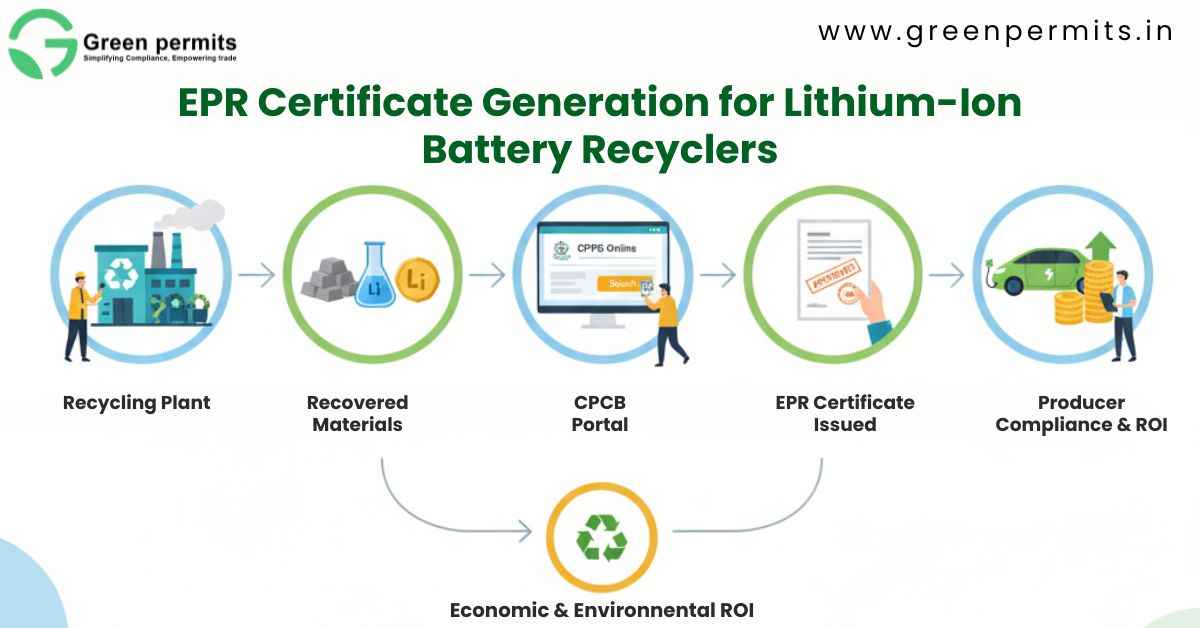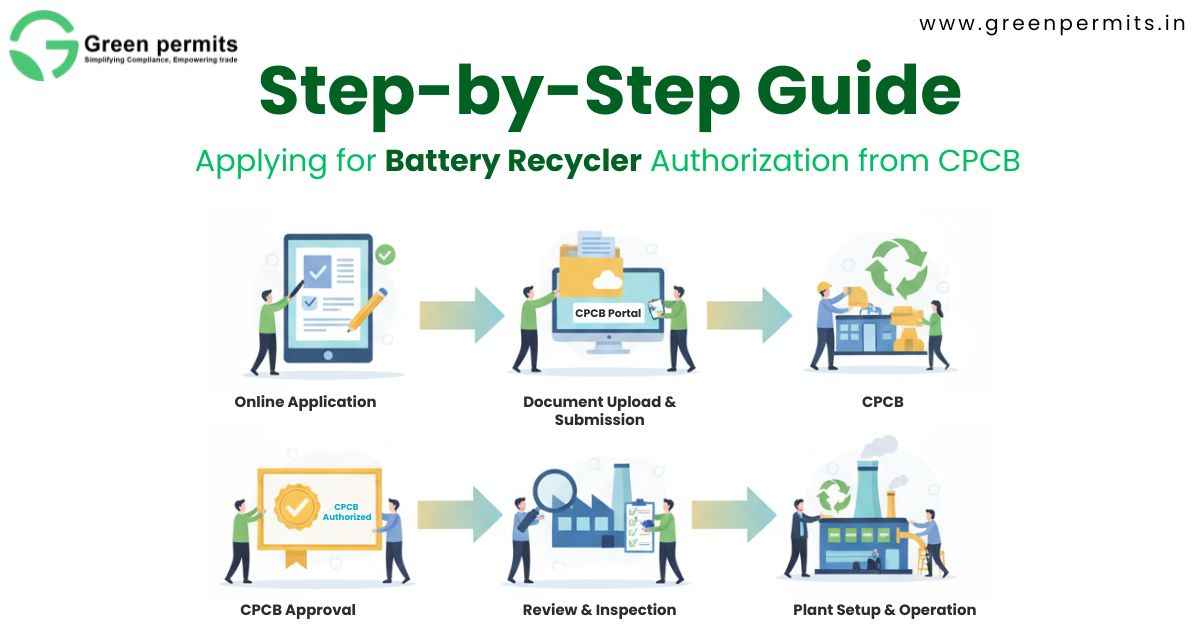When Rahul, who runs a small lithium-ion battery recycling plant in Pune, tried generating his first EPR certificate, he assumed the CPCB portal would make things simple.
Instead, he spent hours uploading data, waiting for validation, and trying to understand why the “Generate Certificate” button stayed inactive.
This situation is familiar to hundreds of recyclers across India. The process is straightforward once understood, but the lack of step-by-step guidance creates costly delays.
This guide explains how EPR certificate generation actually works — so recyclers can save time, stay compliant, and grow their business confidently.
Understanding What an EPR Certificate Means for Recyclers
Before exploring the process, it’s crucial to know why EPR certificates exist.
Under the Battery Waste Management (BWM) Rules, 2022, every producer of batteries (EV, consumer, industrial, etc.) has a recycling obligation.
They meet that obligation by purchasing EPR certificates — proof that an equivalent quantity of batteries has been recycled responsibly.
Recyclers, therefore, play a central role.
They generate EPR certificates once they have processed waste batteries and submitted proof through the CPCB online portal.
These certificates have market value, making compliance not just a duty, but also a potential revenue opportunity.
In simple terms:
- Recyclers prove actual recycling through the CPCB system and earn certificates.
- Producers and importers buy those certificates to fulfill their targets.
- CPCB ensures transparency and traceability through its online platform.
How the CPCB EPR Portal Works
The EPR Battery Portal of the Central Pollution Control Board (eprbattery.cpcb.gov.in) is where every authorized recycler must register and manage EPR activity.
Once approved by CPCB, recyclers can record every shipment, upload processing data, and generate EPR certificates for the quantity verified.
Key Portal Features
- Online registration and dashboard: Manage authorization, returns, and recycling data.
- Certificate tracking: Monitor how many certificates have been generated and transferred.
- Automated verification: Data is validated based on reports and transporter manifests.
- Annual and quarterly returns: Ensure transparency for both recyclers and CPCB.
Step-by-Step Process to Generate an EPR Certificate
Once a recycler is authorized, the portal follows a specific flow.
While CPCB doesn’t number steps publicly, here’s the natural sequence based on official manuals and industry practice:
1. Login and Data Entry
Upload details of recycled batteries — type (Li-ion, lead-acid, etc.), quantity in kilograms, and source producer or collector.
Ensure data matches invoices and manifests to avoid rejection later.
2. CPCB Verification
The system cross-checks entries with waste battery procurement records and transporter data.
If discrepancies appear, CPCB may request clarification before approval.
3. Certificate Generation
After successful validation, the “Generate Certificate” tab activates.
Recyclers select the verified batch, choose the relevant battery category, and the portal auto-calculates the eligible quantity for certificate generation.
4. Certificate Transfer
The generated certificate can be directly transferred to a producer or importer on the same portal.
Rates vary, but for lithium-ion recyclers, the average value ranges between ₹20–₹50 per kilogram depending on demand.
EPR Certificate Value and Market Potential
EPR certificates have emerged as a new revenue component for recyclers.
As India’s EV and electronics sectors grow, the demand for Li-ion certificates is rapidly increasing.
Here’s an indicative overview of the value range:
| Battery Type | Average Certificate Value (₹/kg) | Average Target Fulfillment (%) | Key Insight |
|---|---|---|---|
| Lithium-Ion | ₹20 – ₹50 | 35–50 % | Growing demand; EV growth driving prices |
| Lead-Acid | ₹10 – ₹25 | 70–80 % | Stable market; mature recycling sector |
| Nickel-Cadmium / Others | ₹15 – ₹30 | 25–40 % | Niche category, smaller trading volumes |
What this means:
A recycler processing 1,000 tons of Li-ion batteries could potentially generate certificates worth ₹2–5 crore annually, depending on current rates and trading volumes.
Documents Needed for Smooth EPR Certificate Generation
Many recyclers face delays because of incomplete documentation.
Below is a practical checklist that every recycling unit should maintain:
| Required Document | Purpose | Issued/Uploaded By |
|---|---|---|
| Valid CPCB/ SPCB Recycler Authorization | Confirms legitimacy of operations | CPCB/SPCB |
| Monthly Recycling Return | Reports recycled battery quantity | Recycler (portal submission) |
| Purchase & Sale Invoices | Proof of waste inflow and recycled output | Recycler |
| Transporter Manifest | Confirms movement of waste from producer to recycler | Authorized transporter |
| EPR Certificate Request Log | Tracks submitted requests for verification | Recycler |
If any of these documents are missing or inconsistent, CPCB can delay approval by up to 45 days, especially during quarterly audits.
Risks and Penalties for Non-Compliance
Non-compliance doesn’t just slow business — it can block certificate generation entirely.
Common risks include:
- Late submission of quarterly returns (portal lockout).
- Wrong data entry, especially in weight or chemistry.
- Missing authorization renewal or audit report.
- Selling certificates without valid proof of recycling.
Potential penalties:
Under the Battery Waste Management Rules, CPCB can impose financial penalties up to ₹1 lakh and temporarily suspend authorization.
Example:
A recycler in Haryana delayed uploading data for Q2 FY 2024-25.
CPCB deactivated the account for two months, halting all EPR transfers and causing direct business losses from cancelled producer contracts.
Why Timely Certificate Generation Is a Business Advantage
While the regulation focuses on environmental responsibility, the business case is equally strong.
- Builds producer confidence: Producers prefer recyclers who can issue EPR certificates on time.
- Improves cash flow: Certificates can be sold or transferred, creating an additional revenue stream.
- Simplifies license renewal: On-time submissions ensure smoother interactions with CPCB/SPCB.
- Strengthens partnerships: Reliable EPR handling builds long-term relationships with OEMs and importers.
Ultimately, early adoption positions recyclers as industry leaders ready for India’s circular economy growth.
India’s Recycling Capacity Gap and Opportunity
| Metric | Current (2024) | Projected 2030 | Gap / Opportunity |
|---|---|---|---|
| Li-ion Battery Demand (GWh) | ~25 GWh | 230 GWh | +205 GWh growth |
| Installed Recycling Capacity (tons/year) | 35,000 t | 150,000 t+ | 4× expansion needed |
| Registered Recyclers (CPCB Portal) | 4–6 | >50 expected | Huge new-entry potential |
Interpretation:
With such a large capacity gap, recyclers who complete EPR authorization and begin certificate generation early will enjoy strong market positioning and long-term profit potential.
Practical Example: Lohum Cleantech
Delhi-based Lohum Cleantech demonstrates how recyclers can turn compliance into business growth.
By efficiently processing Li-ion scrap and promptly issuing EPR certificates, Lohum not only supports producers’ compliance but also earns additional revenue.
Its transparent model shows how aligning business goals with regulatory obligations benefits both recyclers and the environment.
Conclusion
Generating EPR certificates isn’t just about ticking a compliance box — it’s about securing a stronger, cleaner, and more profitable business.
Recyclers who streamline their CPCB submissions and maintain clear documentation save time, avoid penalties, and build credibility in a rapidly evolving market.
Compliance done right creates opportunity.
Start early, stay organized, and lead India’s lithium-ion recycling revolution.
📞 +91 78350 06182 | 📧 wecare@greenpermits.in
Book a Consultation with Green Permits
Book a Technical Call with Expert
FAQs
By uploading verified recycling data and submitting it for CPCB validation through their registered account.
Each certificate remains valid for up to seven years from its issue date.
Yes. Authorized recyclers can transfer them directly to producers/importers via the CPCB portal.
CPCB can suspend authorization and restrict certificate generation until data is updated.
Depending on processing volume and rates (₹20–₹50 per kg), a mid-sized recycler could earn several crores annually.



